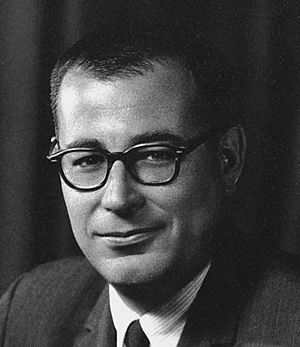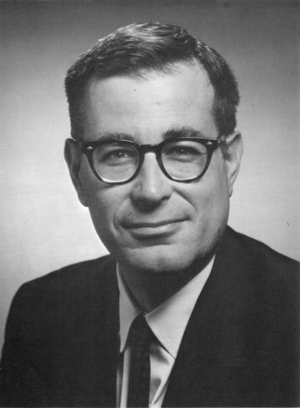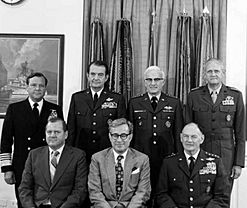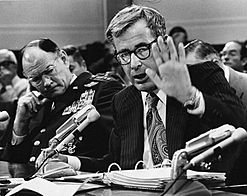Harold Brown (Secretary of Defense) facts for kids
Quick facts for kids
Harold Brown
|
|
|---|---|
 |
|
| 14th United States Secretary of Defense | |
| In office January 20, 1977 – January 20, 1981 |
|
| President | Jimmy Carter |
| Preceded by | Donald Rumsfeld |
| Succeeded by | Caspar Weinberger |
| 3rd President of the California Institute of Technology | |
| In office 1969–1977 |
|
| Preceded by | Lee Alvin DuBridge |
| Succeeded by | Robert F. Christy (acting) |
| 8th United States Secretary of the Air Force | |
| In office October 1, 1965 – February 15, 1969 |
|
| President | Lyndon B. Johnson |
| Preceded by | Eugene M. Zuckert |
| Succeeded by | Robert Seamans |
| 2nd Director of Defense Research and Engineering | |
| In office May 8, 1961 – September 30, 1965 |
|
| President | John F. Kennedy Lyndon B. Johnson |
| Preceded by | Herbert York |
| Succeeded by | John S. Foster Jr. |
| Personal details | |
| Born | September 19, 1927 New York City, U.S. |
| Died | January 4, 2019 (aged 91) Rancho Santa Fe, California, U.S. |
| Political party | Democratic |
| Spouse |
Colene Dunning McDowell
(m. 1953) |
| Children | 2 |
| Education | Columbia University (BS, MS, PhD) |
| Scientific career | |
| Fields | Nuclear physics Atomic physics |
| Institutions | Lawrence Livermore National Laboratory California Institute of Technology |
| Thesis | Beta-spectra of gaseous argon-41 and oxygen-15 (1951) |
| Doctoral advisor | Isidor Isaac Rabi |
Harold Brown (born September 19, 1927 – died January 4, 2019) was an American nuclear physicist. He served as the United States Secretary of Defense from 1977 to 1981 under President Jimmy Carter.
Before this, he held important roles in the governments of John F. Kennedy and Lyndon B. Johnson. These included Director of Defense Research and Engineering (1961–1965) and United States Secretary of the Air Force (1965–1969).
Harold Brown was a child prodigy, meaning he was very talented from a young age. He finished high school at 15 and earned his Ph.D. in physics from Columbia University at 21. As Secretary of Defense, he helped set up the Camp David Accords. He also worked on talks with the Soviet Union to control nuclear weapons.
Contents
Early Life and Education

Harold Brown was born in Brooklyn, New York. His father, Abraham, was a lawyer who fought in World War I. His mother, Gertrude, was a bookkeeper. His parents were Jewish and supported President Franklin D. Roosevelt.
From a very young age, Harold loved mathematics and physics. He went to the Bronx High School of Science, a special school for smart students. He graduated at age 15 with excellent grades.
He then went straight to Columbia University. He earned his first degree at 17 with high honors. He continued his studies there and received his Ph.D. in physics in 1949 when he was 21 years old.
Early Career in Science and Government
After teaching for a short time, Brown became a research scientist. He worked at the Radiation Laboratory at the University of California, Berkeley. There, he helped build the Polaris missile and worked with plutonium.
In 1952, he joined the University of California Radiation Laboratory at Livermore. He became its director in 1960, taking over from Edward Teller. At Livermore, Brown led a team that used early computers and math. They worked to make nuclear warheads smaller and lighter. This helped the Navy put them on nuclear-powered ballistic missile submarines.
During the 1950s, he advised the government on science. He also worked at a conference about stopping nuclear tests.
Brown then worked for the government under Secretary of Defense Robert McNamara. He was the Director of Defense Research and Engineering from 1961 to 1965. After that, he became the United States Secretary of the Air Force from 1965 to 1969.
From 1969 to 1977, he was the President of the California Institute of Technology (Caltech).
U.S. Secretary of Defense
Becoming Secretary of Defense
Harold Brown was the first natural scientist to become Secretary of Defense. He had almost eight years of experience working at the Pentagon. He was involved in almost every part of the defense department.
He started a big review of how the defense department was organized. This led to important changes. Brown also believed in improving U.S. military forces. He wanted to make security agreements with other countries stronger. He also strongly supported controlling nuclear weapons.
Brown believed in "essential equivalence" with the Soviet Union in nuclear power. This meant that the Soviet Union's nuclear forces should not give them a political or military advantage. The U.S. forces needed to be seen as equal in strength.
Experts later said that President Jimmy Carter and Harold Brown actually started increasing defense spending. This was to keep up with the Soviet Union. They improved land-based missiles and bombers. They also added more missiles to submarines.
Nuclear Weapons and Strategy
Brown thought it was very important to keep the "nuclear triad" strong. This means having nuclear weapons that can be launched from:
- ICBMs (missiles on land)
- SLBMs (missiles from submarines)
- Strategic bombers (planes).
He decided not to build the B-1 bomber. Instead, he suggested upgrading existing B-52s with new missiles. He also approved developing "stealth" technology. This technology makes planes very hard for enemy radar to detect.
The administration also supported developing the MX missile. This missile was meant to replace older ones like the Minuteman. To protect the MX missiles, Brown suggested putting them in "multiple protective shelters." This meant 200 MX missiles would be moved among 4,600 different shelters. This plan was expensive, but Brown believed it was the best way to protect the missiles.
For the sea part of the triad, Brown sped up the development of the larger Trident nuclear submarine. He also converted older Poseidon submarines to carry many warheads on one missile.

By 1979, Brown and his team created a "countervailing strategy." This was a way to plan how nuclear weapons would be used. Brown explained that the U.S. needed forces and plans so that an enemy would know they could not win if they attacked. This idea was meant to stop attacks from happening.
This strategy became official with President Carter's approval of Presidential Directive 59 (PD 59) in July 1980. Brown said PD 59 was not a new plan, but a clearer way of explaining existing policy. He insisted it was not a plan to start a nuclear war. He said, "Nothing in the policy means that nuclear war can be a way to reach our national security goals."
Strengthening NATO

Brown believed that making NATO stronger was a key goal for national security. NATO is a military alliance of countries in North America and Europe. He worked hard to make the alliance more active.
In May 1978, NATO leaders agreed on a long-term defense plan. This plan included improving readiness, quick reinforcements, and stronger air defenses. It also focused on better communication and working together on weapons.
To counter new Soviet nuclear weapons, NATO decided in December 1979 to place new missiles in Western European countries. This deployment would start in December 1983. However, NATO leaders said they would reduce the new missile deployment if talks with the Soviet Union went well.
Brown also urged NATO members to increase their defense spending by three percent each year. This was to make sure NATO's forces could match those of the Soviet bloc. Brown was happy with NATO's progress. He felt that revitalizing NATO was his most important achievement.
Brown also tried to strengthen the defense efforts of U.S. allies outside of NATO. These included Japan and South Korea. He encouraged Japan to spend more on its defense. This would help Japan take on a bigger role in protecting the Pacific.
The Carter administration first planned to remove U.S. ground forces from South Korea. But because North Korea's military grew stronger, the plan was stopped. About 40,000 U.S. troops remained in Korea.
In 1979, the U.S. officially recognized the People's Republic of China (PRC). A year later, Brown visited China. He talked with their leaders and helped set up cooperation on security issues.
Arms Control Efforts
Controlling weapons was a big part of Brown's national security policy. He strongly supported the SALT II treaty signed in June 1979 between the U.S. and the Soviet Union. He was the main person trying to get the Senate to approve it.
SALT II limited both sides to 2,250 strategic nuclear delivery vehicles. These included bombers and different types of missiles. It also set limits on the number of warheads on each missile. The treaty allowed each side to check on the other using their own technology.
Brown explained that SALT II would reduce Soviet forces. It would also make the nuclear relationship between the U.S. and the Soviet Union more predictable. He said it would lower the cost of keeping a balance of power. It would also help the U.S. watch Soviet forces and reduce the risk of nuclear war.
Critics of SALT II said the U.S. had underestimated the Soviet military. They also said the treaty would weaken Western alliances. Brown argued against these points. To try and get the Senate to agree, the Carter administration agreed to increase the defense budget.
However, the Soviet invasion of Afghanistan in December 1979 stopped the Senate from approving the treaty. President Carter had to withdraw it. Brown later said that not getting SALT II approved was his biggest regret. Even without official approval, both the U.S. and the Soviet Union followed the treaty's rules until 1986.
Dealing with Regional Issues
Panama Canal
Brown also handled other important issues, like the Panama Canal. Control of the Panama Canal Zone had been a problem since Panama became independent in 1903.
After some problems in the 1960s, the U.S. and Panama started talks. In September 1977, they signed two treaties. One said Panama would fully control the canal by the year 2000. The other guaranteed the canal would remain neutral. The Defense Department played a big part in these talks. Brown strongly supported the treaties. He helped get them approved by the Senate in 1978. He said they were good for the U.S. and important for the canal's future.
Middle East Challenges
In the Middle East, Brown supported President Carter's efforts to help Egypt and Israel negotiate. This led to the Camp David Accords in September 1978. It also led to a peace treaty between the two nations in March 1979.
However, the fall of the Shah in Iran in January 1979 caused many problems for U.S. policy. In November 1979, Iranian revolutionaries took over the U.S. embassy in Tehran. They held more than 50 Americans hostage. Brown was involved in planning a rescue mission. But the mission failed, and eight U.S. servicemen died in April 1980. The hostages were not released until the last day of President Carter's time in office, in January 1981.
Soviet Invasion of Afghanistan
The Soviet invasion of Afghanistan in December 1979 made the situation in the Middle East even more difficult. In response to events in Iran and Afghanistan, Brown created the Rapid Deployment Joint Task Force (RDJTF) in March 1980. This group was responsible for planning quick military operations, especially in Southwest Asia.
Defense Budget
Dealing with the budget took up a lot of Brown's time. During his campaign, President Carter had promised to cut defense spending. When Brown became Secretary, he suggested cutting the budget by almost $3 billion. However, the overall defense budget still increased.
Later budgets under Brown generally went up. This was due to high inflation and the need to improve military forces. There were also serious challenges in the Middle East, Iran, and Afghanistan.
By the time he left office, Brown said the Defense Department budget was 10 to 12 percent higher than when he started. This was a difficult achievement, especially since Carter had promised to cut spending. With the increased budget, Brown oversaw the development of "stealth" aircraft. He also sped up the Trident submarine program.
Leaving Office
Brown left his position on January 20, 1981. This was after President Carter lost his bid for re-election. During the 1980 election campaign, Brown actively defended the Carter administration's policies. He often spoke publicly about national issues.
President Carter gave Brown the Presidential Medal of Freedom in 1981. President Bill Clinton gave him the Enrico Fermi Award in 1993.
Later Life
After leaving the Pentagon, Harold Brown stayed in Washington, D.C.. He became a visiting professor at the Johns Hopkins University School of Advanced International Studies. He later became chairman of the university's Foreign Policy Institute. He continued to speak and write about national security. In 1983, he published a book called "Thinking About National Security."
In his later years, Brown worked with research groups. He also served on the boards of several companies.
In 2006, he attended a meeting at the White House. He met with other former Secretaries of Defense and State to discuss U.S. foreign policy.
In 2011, Brown joined the United States Energy Security Council. This group works to reduce the U.S. transportation sector's reliance on oil.
Harold Brown died on January 4, 2019, at the age of 91. He passed away from pancreatic cancer.
See also
 In Spanish: Harold Brown para niños
In Spanish: Harold Brown para niños
- Harold Brown Award




